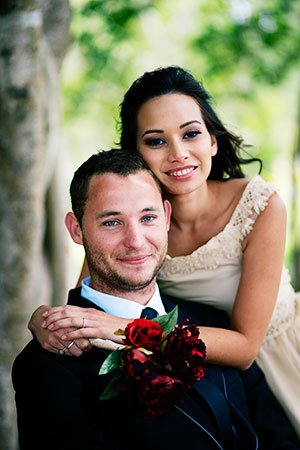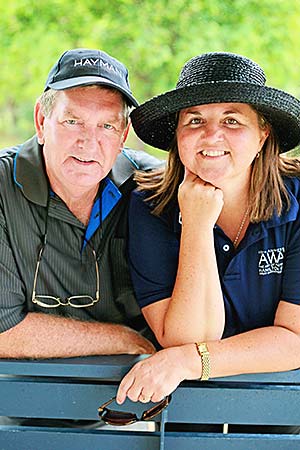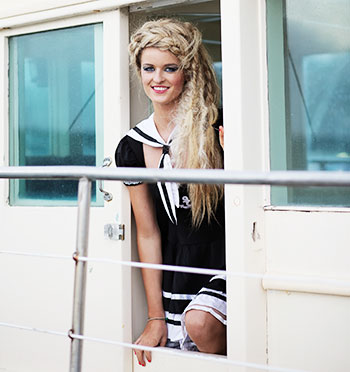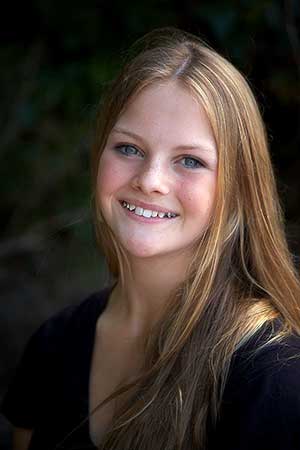No matter what camera brand or model you photograph with, all the best portrait lens have several things in common.
For starters, a good portrait lens should open as wide as aperture f/1.8 or less. Many of the best portraits are candid shots when people think the cameras focus is off them.
For weddings and commercial work, we’ll initially set a scenario up and its those few moments afterwards when the person has relaxed that we’ll get our money shots. For these moments, you need a fast lens.
Best mid priced portrait lens
Now you might be thinking, but hang on aren’t fast lenses expensive? Not necessarily so. For my wedding and commercial work photographing people, I don’t shoot with what Canon refers to as a professional L lens. Instead my tool of preference is a much cheaper Canon EF 85mm f/1.8 USM Lens which last I checked was approximately $420 USD.
My partner who shoots beside me prefers his Canon EF 50mm f/1.4 USM, cheaper yet again at $380 USD!
The equivalent of these lenses for Nikon users are the 85mm f/1.8G AF-S NIKKOR Lens or the 50mm f/1.4D AF Nikkor Lens.
The wedding photo above was taken with a Canon EF 85mm f/1.8 USM Lens.
Best low cost portrait lenses
These portrait lenses mentioned so far are mid range as far as price goes. If you are a beginner and need a cheap lens to learn with I recommend trying a Nikon 50mm f/1.8D AF Nikkor Lens or for Canon photographers the EF 50mm f/1.8 II lens, both with a low price of under $100.
Note, the Autofocus on the Nikon lens won’t work with D40/D60/D3000/D5000 models. So if you have one of these camera bodies you might want to consider the 85mm f/1.8G AF-S NIKKOR Lens instead.
So what’s the main difference between these inexpensive portrait lenses compared to the more expensive ones I mention next?
For starters they look and feel cheaper to hold. They are normally made of plastic whereas the more expensive lenses are metal. Of course the more expensive portrait lenses should be sharper. However as a beginner you won’t have anything to compare the lower cost lens with, so personally that’s not a big deal when you are still learning.
That’s not saying these low cost lenses aren’t sharp. You only need to read the comments on Amazon to know that every lens mentioned here is super sharp.
Our daughter Danielle took this image of us with her EF 50mm f/1.8 lens.
Best professional portrait lenses
At the other end of the scale, if you don’t mind paying out the big bucks on camera gear, the choice of lens for Nikon professionals is the 85mm f/1.4G AF-S Nikkor Lens, priced at $1649. Now for Canon photographers you would think this is where I’d recommend a professional L lens, like the EF 85mm f1.2L II USM Lens that sells for $1579.
However, this is one of those cases where more expensive doesn’t necessarily mean better. Here is why.
All reports are clear that the Canon EF 85mm f1.2L II USM Lens is a slow lens to autofocus compared to other cheaper models. Great if your portrait style is of families sitting around grouped together and no one moves. However for kids or weddings where people are on the move, that once off special moment is usually gone by the time this lens auto focusses.
Hence, the reason I prefer the mid range Canon EF 85mm f/1.8 USM portrait lens. Other professionals prefer the more versatile Canon EF 70-200mm f/2.8L IS II USM. However that also comes with a hefty price tag of $2499 USD.
What do all these lenses have in common?
Ok so all these lenses mentioned so far are of different price levels, so what makes them all a great portrait lens? (not including the alternative Canon EF 70-200mm f/2.8L IS II USM)
- All are fast lenses that open wide to a minimum of f/1.8. Not only does that mean they are super fast, it also means you can create beautiful background blur, isolating your main subject.
- All are prime lenses. Meaning they don’t zoom in and out. Instead you need to physically move yourself into position. Prime lenses are well known for being much sharper than non primes. In my opinion they are also more reliable with less moving parts.
- Setting a lower aperture f-number means they are perfect for low light or indoor situations. Great for room shots of brides getting ready for their big day, church weddings, or the dance floor in the evening when the photographer doesn’t want to use a flash.
A fashion shoot I did recently with a Canon EF 85mm f/1.8 USM Lens. A fast lens with a low aperture f/1.8 was important for this commercial job. It was photographed late in the evening as the available daytime light was quickly fading.
Is a dedicated macro lens good for portraits?
This is always a matter of personal preference. Personally I don’t like using macro lenses for portraits. Especially close-up portraits. I find them too harsh. No one likes looking at photos of themselves where they can see every line in their face or blackhead in their nose.
Dedicated macro lenses are created for high detailed shots. In my experience higher selling portrait photos tend to be much softer.
How about using mid zoom lenses for portrait photography?
Let say you already own a general walk around lens similar to the Canon EF 24-105mm f/4 L IS USM Lens and are wondering if it’s ok for portrait photography.
A well known portrait and glamour photographer, Sue Bryce, says often that the EF 24-105mm f/4 L IS USM is her favourite lens.
Hang on you’re thinking, this goes against everything I said earlier. The lowest aperture this lens goes to is f/4 and it’s a non prime! Keep in mind she also shoots with a 50mm f/1.2L and the 35mm f/1.4L.
I agree, there are times, when your general walk around lens with an f/4 aperture will be sufficient for portrait photography. Take this portrait of a young girl that I photographed last year for example.
How I took this image
For this image I used a Canon EF 24-105mm f/4 L IS USM lens as I didn’t have my usual portrait setup with me at the time. When using such a lens for portraits its important to think more about the shot beforehand. In this case, the subject was not moving (huge advantage if shooting at f/4 speed). It’s a classic portrait shot.
We positioned the girl with ample space between her body and the foliage seen behind her. This enabled me to blur the background nicely while using f/4 aperture. I am standing as close to her as the camera would physically enable me, yet still be able to focus while the camera lens was set on 105mm focal length.
Notice the softness in her shoulder? This is due to positioning her at an angle with her right shoulder turned slightly away from the camera. Her eyes are now closer to the camera than her shoulder, therefore using the lowest f-number this lens would go, I focussed on her eyes which resulted in that beautiful softness in her right shoulder.
Sharpness of images
Note the examples you see on this page have been optimized for internet viewing. The original files are much sharper than they may appear. I hope this helps you choose the best portrait lens for your needs.
Sign-up for our online bird photography course and learn how to take better bird photos in easy to understand “at your own pace” lessons.
Click here for more information and sign-up details!



